Model A Wishbones (1928-1931)
The Model A Wishbone is the shortest or the group, measuring 39 inches from the center of the spring perch boss at the front, to the center of the "mounting ball" at the back.
The mouth at the front of the wishbone is 2 and 1/4 inches wide, and has very little caster built into it:

1932 Wishbone
Like everything else on a '32 ford, this style of wishbone was only made for one year. It's much longer than a Model A wishbone measuring 47 and 1/2 inches from the center of the spring perch boss at the front, to the center of the "mounting ball" at the back.
The mouth at the front of the wishbone is only 2 inches wide, and has a considerable amount of caster built into it compared to the Model A:

1933-'34 Wishbone
The 1933-'34 Ford wishbone is basically the same as the '32, except that it's two inches shorter. Measuring 45 and 1/2 inches from the center of the spring perch boss at the front, to the center of the "mounting ball" at the back.
The mouth is also 2 inches wide, and it has the same amount of caster as the '32.
1935-'36 Wishbone
There are two differences between the 1933-'34 wishbones and the 1935-'36 bones. The first change isn't as noticeable. '35-'36 are one inch shorter than the '33-'34 wishbones, measuring 44 and 1/2 inches from the center of the spring perch boss at the front, to the center of the "mounting ball" at the back.
The second difference is something you can spot from twenty feet away. Starting in 1935, Ford began casting a spring hanger on the front of the wishbones and stopped using a spring perch that goes through the axle.
The mouth is still 2 inches wide:

1937-'41 Wishbone
While the 1937-'41 Ford wishbone appears the same as the '35-'36 wishbone with the spring hanger on the front, also measuring 44 and 1/2 inches. The one major difference is that Ford went back to using a 2 and 1/4 inch axle, so the mouth on the front of the '37-'48 wishbone is 2 and 1/4 inches wide.
(Photo below shows a 37-'41 wishbone with the front spring hanger cut off and the end rounded over)

1942-'48 Wishbone The 1942-'48 Ford wishbones saw a major increase in the over all length. Measuring 50 and 1/2 inches from the center of the spring perch boss at the front, to the center of the "mounting ball" at the back, this is the longest wishbone Ford ever made.
While the mouth remained 2 and 1/4 inches wide, and the spring hanger was still cast into the front (note: all Ford wishbones from 1935 onward had a spring hanger cast into the front of the wishbone) a step was also added to the front end.
(Photo below shows a "42-'48 wishbone with the front spring hanger cut off)

. . . in 1949 Ford starting manufacturing cars with independent front suspension, and the Ford wishbone became a thing of the past.
The Ford I beam axle as its known was in production from the A model through to 1948. Whilst the T model are also an I beam they are not able to be readily used on later Fords.
The nomenclature of I beam came from the presentation of the axle when viewed in a cross section. Think railway track and you pretty much have what the cross section of an early ford axle looks like.
There are really 6 main types of early Ford I beam 7 if you include the V8-60 which is mostly the domain of the sprint car guys.
These are pictured below. This photo comes from an old Rod and Custom mag from memory or it could have been street rodder? I saved this picture years ago so can’t remember where I got it from. It shows the different types of axle.
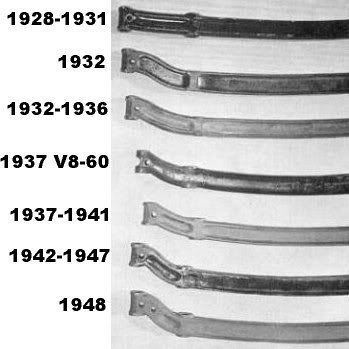
The there are a few things you need to know about each axle. The biggest thing you need to know is, are you going to drop it or not? A few years ago that was the main thing rodders did with axles, so certain axles were more sort after than others.
Nowadays, people are sweeping and “Z”ing frames not only at the rear but also at the front, so this opens up a whole new world of use for the latter axles.
The main points of reference are the distance between the spring perch boss’s (these are the most inboard boss’s) as this helps figure out you your spring length (Remembering that after 1934 that the spring was positioned in front of the axle).
The distance between the spring perch boss’s and the king pin boss’s also helps. This is important in determining how much “drop” you can get out of your axle. Also the depth of your boss’s is a measurement to know. This especially helps you with fitting early spindles to your axle.
If you are considering dropping your axle the overall length isn’t that important, as in the process of dropping the axle the overall length shortens. So if your not dropping the axle, but going with a suicide front end (axle in front of the chassis) the overall length may be of concern so you can work out the front track width.
When an axle is dropped the amount dropped is on top of the factory drop. So for instance, my 1932 axle was dropped 3” this gives me equivalent to a 4” drop overall compared to other axles like the A model as the 1932 axle already has a 1” factory drop in it.
The A model axle ran for 3 years, 1928-1931 they have a set curve through the whole axle. The bosses are 2 ¼” The distance between the spring perch and king pin bosses allow for a decent drop, however as the actual axle’s I beams section is narrow the can get rather thin if your chasing a decent drop. The kingpin original distance is 51 7/8” the spring perch centre to centre is 36 ¼
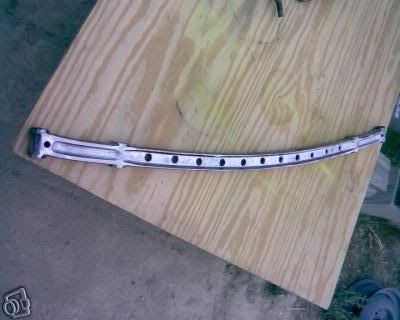
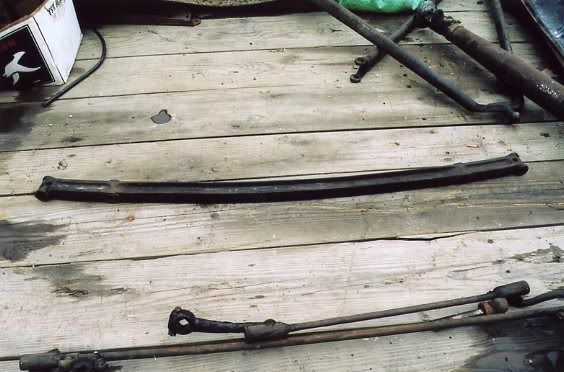 7
7 1932. Single year only and “the” one to have. Often referred to as the heavy axle. You can see why in the above photo. It’s a chunkier axle all round. They can be stretched as far as 5” of drop. These are the axles that made Ed “dago” Stewart famous for his ‘dago’ axles. The ‘dago’ is not thought to be an ethnic nickname, but more that he was out of the San Diego area.
These axles already had a 1” drop from the factory, but as hot rodder are hot rodders, that wasn’t enough.
Measurements are Kingpin to kingpin 51 ¾”, spring perch to spring perch 36 3/8”, Boss’s 2”
This is a photo of an un-dropped 1932 axle.
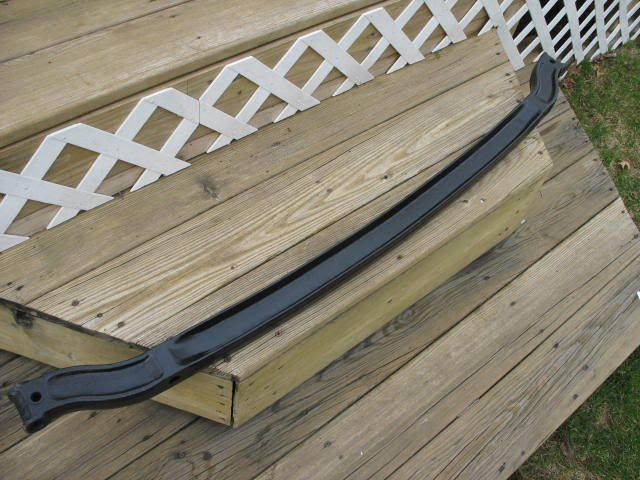
You can see the thickness in the area between the spring perch and king pin bosses and the greater curve between the spring perch boss’s (the inboard boss) and the kingpin boss’s. Compared to the A model.
This is a dropped version. The other reason I have heard that they are referred to as I beam axles, is the spring perch boss look. The below photo shows how it looks like a capital I. Regardless, the name is common use for any early Ford axle now a days.
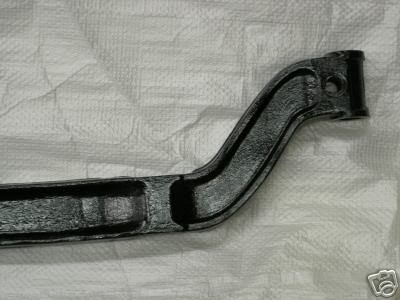
1933-1936 are apparently the same measurements as the 32. I can’t verify or deny this but will measure a 33 axle to check. These axles are good to drop though as there is enough distance between the kingpin and perch boss’s to get a decent drop.
1937-1941 from here on in most don’t worry with these axles as they don’t allow a lot of drop. The measurements are. Kingpin to kingpin 50 7/8” .spring perch to spring perch 38 1/2” boss’s 2 1/4”
1942-1947 again, not the most sort after axle. Measurements are. Kingpin to kingpin 52” spring perch to spring perch 40 5/8” boss’s 2 ¼ notice also that there is an extra hole in the front of the axle near where the lock pin for the kingpin goes. This is for the front shocks to mount to.
1948 same as 42-48 but notice that there is an extra hole in the front of the axle near where the lock pin for the kingpin goes. This is for the front shocks to mount to.
Be nice to see photo rather than having to pay for it, Cant work that out.
ReplyDeleteAnyway nice post, took 2 days trying to find lengths. Thanks for that, would love to see your cars that you building or built.